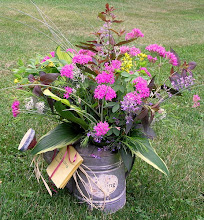 Today's perennial spotlight is on a plant that not too many people grow. Thalictrum flavum subsp. glaucum (commonly called meadow rue) has been growing in my garden for at least 10 years. It's one of those treasures I bought many years ago at Franks nursery.
Today's perennial spotlight is on a plant that not too many people grow. Thalictrum flavum subsp. glaucum (commonly called meadow rue) has been growing in my garden for at least 10 years. It's one of those treasures I bought many years ago at Franks nursery.I have it in a lousy spot, extremely dry, shade for most of the day except two hours of direct sun right around noon.
 One of the mistakes I made with this lovely perennial is planting it at the edge of a border. In a shaded spot like this it wants to lean towards the sun and there's nothing much there for it to lean on.
One of the mistakes I made with this lovely perennial is planting it at the edge of a border. In a shaded spot like this it wants to lean towards the sun and there's nothing much there for it to lean on.I did put a metal structure there and have a few wires to help it stay inside the form but it really isn't the right spot at all for this perennial. The piece I've moved to a sunny area is much happier but too small to photograph right now.
 Unlike the other Thalictrums I grow, this variety has blue foliage, hence the word "glaucum" in it's name. The blue foliage and the sulphur yellow blooms are a great combination!
Unlike the other Thalictrums I grow, this variety has blue foliage, hence the word "glaucum" in it's name. The blue foliage and the sulphur yellow blooms are a great combination! If you leave your Thalictrums alone (that means leaving those ugly dead blooms on them for awhile), they will scatter a few seedlings. For some reason I've got a bunch of little babies growing right out of the cracks of the belgium block border of my driveway. The foliage is in the bottom left corner, the bloom is in the top right corner.
If you leave your Thalictrums alone (that means leaving those ugly dead blooms on them for awhile), they will scatter a few seedlings. For some reason I've got a bunch of little babies growing right out of the cracks of the belgium block border of my driveway. The foliage is in the bottom left corner, the bloom is in the top right corner. Other Thalictrums grow here too. Next to my telephone pole is a large clump of Thalictrum
Other Thalictrums grow here too. Next to my telephone pole is a large clump of Thalictrum'Elin'. I just did a quick search on this plant and was surprised to see that it is a cross between Thalictrum flavum subsp. glaucum and Thalictrum rochebrunianum (hmmm, a thalictrum I don't grow!).
Now this is a case of the right plant in the right location. It's at least 8 feet tall right now and stands up perfectly straight.
 At the total opposite spectrum is the teeny tiny Thalictrum kiusianum. This dwarf Thalictrum is so small that if you didn't know it was here you'd mistake it for clover or some other little thing. Last year I planted a piece in a dish garden and it did better there than it does in the garden. Maybe it finally feels it has room to grow without any thugs taking over?
At the total opposite spectrum is the teeny tiny Thalictrum kiusianum. This dwarf Thalictrum is so small that if you didn't know it was here you'd mistake it for clover or some other little thing. Last year I planted a piece in a dish garden and it did better there than it does in the garden. Maybe it finally feels it has room to grow without any thugs taking over?Oops, looking at the photo I see exactly that, a little piece of clover snuck right in the middle :-)
 Most likely the most well known Thalictrum is Thalictrum aquilegifolium. As the name says, the foliage looks just like an Aquilegia (columbine) and many people mistake it for one, that is, until it blooms.
Most likely the most well known Thalictrum is Thalictrum aquilegifolium. As the name says, the foliage looks just like an Aquilegia (columbine) and many people mistake it for one, that is, until it blooms.I find Thalictrums easy to grow, they have no pests that I'm aware of and require little extra care. Try one out, I think you'll love them!
Melanie



































